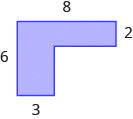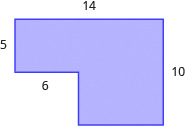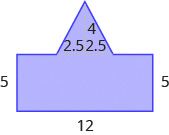6.3 Solve Geometry Applications: Circles and Irregular Figures
Learning Objectives
By the end of this section, you will be able to:
- Use the properties of circles
- Find the area of irregular figures
Try It
Before you get started, take this readiness quiz:
1) Evaluate [latex]x^2[/latex] when [latex]x\;=\;5[/latex].
2) Using [latex]3.14[/latex] for [latex]\mathrm\pi[/latex], approximate the (a) circumference and (b) the area of a circle with radius [latex]8[/latex] inches.
3) Simplify [latex]\frac{22}7{(0.25)}^2[/latex] and round to the nearest thousandth.
In this section, we’ll continue working with geometry applications. We will add several new formulas to our collection of formulas. To help you as you do the examples and exercises in this section, we will show the Problem Solving Strategy for Geometry Applications here.
HOW TO
Problem Solving Strategy for Geometry Applications
- Read the problem and make sure you understand all the words and ideas. Draw the figure and label it with the given information.
- Identify what you are looking for.
- Name what you are looking for. Choose a variable to represent that quantity.
- Translate into an equation by writing the appropriate formula or model for the situation. Substitute in the given information.
- Solve the equation using good algebra techniques.
- Check the answer in the problem and make sure it makes sense.
- Answer the question with a complete sentence.
Use the Properties of Circles
Do you remember the properties of circles from Decimals and Fractions Together? We’ll show them here again to refer to as we use them to solve applications.
Properties of Circles
- [latex]r[/latex] is the length of the radius
- [latex]d[/latex] is the length of the diameter
- [latex]d\;=\;2r[/latex]
- Circumference is the perimeter of a circle. The formula for circumference is [latex]C\;=\;2\mathrm{πr}[/latex]
- The formula for area of a circle is [latex]A\;=\;\pi r^2[/latex]
Remember, that we approximate [latex]\pi[/latex] with [latex]3.14[/latex] or [latex]\frac{22}7[/latex] depending on whether the radius of the circle is given as a decimal or a fraction. If you use the [latex]\pi[/latex] key on your calculator to do the calculations in this section, your answers will be slightly different from the answers shown. That is because the [latex]\pi[/latex] key uses more than two decimal places. On assessments, we will always give specific instructions on whether to use the approximations above or not.
Example 6.3.1
A circular sandbox has a radius of [latex]2.5[/latex] feet. Find the:
a. circumference
b. area of the sandbox
Solution
a. Step 1: Read the problem. Draw the figure and label it with the given information.
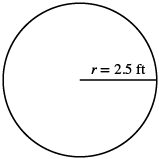
Step 2: Identify what you are looking for.
The circumference of the circle.
Step 3: Name. Choose a variable to represent it.
Let [latex]c=[/latex] the circumference of the circle.
Step 4: Translate.
Write the appropriate formula for the situation and substitute in the given information.
[latex]\begin{eqnarray*}C\;&=&\;2\pi r\\\mathrm C\;&=&\;2\mathrm\pi(2.5)\end{eqnarray*}[/latex]
Step 5: Solve the equation.
[latex]\begin{eqnarray*}C\;&\approx&\;2(3.14)(2.5)\\C\;&\approx&\;15ft\end{eqnarray*}[/latex]
Step 6: Check. Does this answer make sense?
Yes. If we draw a square around the circle, its sides would be [latex]5[/latex] ft (twice the radius), so its perimeter would be [latex]20[/latex] ft. This is slightly more than the circle’s circumference, [latex]15.7[/latex] ft.

Step 7: Answer the question.
The circumference of the sandbox is [latex]15.7[/latex] feet.
b. Step 1: Read the problem. Draw the figure and label it with the given information
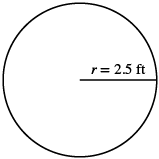
Step 2: Identify what you are looking for.
The area of the circle.
Step 3: Name. Choose a variable to represent it.
Let [latex]A=[/latex] the area of the circle.
Step 4: Translate.
Write the appropriate formula for the situation and substitute in the given information.
[latex]\begin{eqnarray*}A\;&=&\;\mathrm{\pi r}^2\\\mathrm A\;&=&\;\mathrm\pi{(2.5)}^2\end{eqnarray*}[/latex]
Step 5: Solve the equation.
[latex]\begin{eqnarray*}A&\approx&\;(3.14){(2.5)}^2\;\\A&\approx&\;19.625\;sq.\;ft\end{eqnarray*}[/latex]
Step 6: Check. Does this answer make sense?
Yes. If we draw a square around the circle, its sides would be [latex]5[/latex] ft, as shown in part a.. So the area of the square would be [latex]25[/latex] sq. ft. This is slightly more than the circle’s area, [latex]19.625[/latex] sq. ft.
Step 7: Answer the question.
The area of the circle is [latex]19.625[/latex] square feet.
Try It
4) A circular mirror has radius of [latex]5[/latex] inches. Find the a. circumference and b. area of the mirror.
Solution
a. [latex]31.4[/latex] in.
b. [latex]78.5[/latex] sq. in.
Try It
5) A circular spa has radius of [latex]4.5[/latex] feet. Find the a. circumference and b. area of the spa.
Solution
a. [latex]28.26[/latex] ft
b. [latex]63.585[/latex] sq. ft
We usually see the formula for circumference in terms of the radius [latex]r[/latex] of the circle: [latex]C\;=\;2\mathrm{\pi r}[/latex]
But since the diameter of a circle is two times the radius, we could write the formula for the circumference in terms [latex]d[/latex].
Using the Communitive Property, we get: [latex]\begin{eqnarray*}C\;&=\;2\mathrm{\pi r}\\\mathrm C\;&=\;\mathrm\pi2\mathrm r\end{eqnarray*}[/latex]
Then, substituting [latex]d\;=\;2r[/latex]: [latex]\begin{eqnarray*}C\;&=\mathrm{\pi d}\end{eqnarray*}[/latex]
We will use this form of the circumference when we’re given the length of the diameter instead of the radius.
Example 6.3.2
A circular table has a diameter of four feet. What is the circumference of the table?
Solution
Step 1: Read the problem. Draw the figure and label it with the given information.
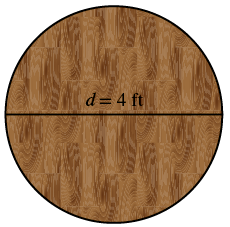
Step 2: Identify what you are looking for.
The circumference of the table.
Step 3: Name. Choose a variable to represent it.
Let [latex]c=[/latex] the circumference of the table.
Step 4: Translate.
Write the appropriate formula for the situation and substitute in the given information.
[latex]\begin{eqnarray*}C\;&=&\;\mathrm{\pi d}\\\mathrm C\;&=&\;\mathrm\pi(4)\end{eqnarray*}[/latex]
Step 5: Solve the equation, using [latex]3.1[/latex]4 for [latex]\mathrm\pi[/latex].
[latex]\begin{eqnarray*}C\;&\approx&\;(3.14)(4)\\C\;&\approx&\;12.56\;feet\end{eqnarray*}[/latex]
Step 6: Check.
If we put a square around the circle, its side would be [latex]4[/latex]. The perimeter would be [latex]16[/latex]. It makes sense that the circumference of the circle, [latex]12.56[/latex], is a little less than [latex]16[/latex].
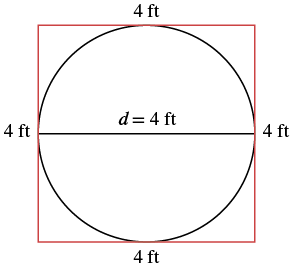
Step 7: Answer the question.
The diameter of the table is [latex]12.56[/latex] square feet.
Try It
6) Find the circumference of a circular fire pit whose diameter is [latex]5.5[/latex] feet.
Solution
[latex]17.27[/latex] ft
Try It
7) If the diameter of a circular trampoline is [latex]12[/latex] feet, what is its circumference?
Solution
[latex]37.68[/latex] ft
Example 6.3.3
Find the diameter of a circle with a circumference of [latex]47.1[/latex] centimetres.
Solution
Step 1: Read the problem. Draw the figure and label it with the given information.
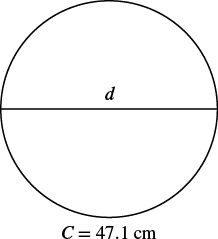
Step 2: Identify what you are looking for.
The diameter of the circle.
Step 3: Name. Choose a variable to represent it.
Let [latex]d=[/latex] the diameter of the circle.
Step 4: Translate.
Write the formula, using [latex]3.14[/latex] for [latex]\mathrm\pi[/latex].
[latex]\begin{eqnarray*}C\;&=&\;\mathrm{\pi d}\\\mathrm C\;&=&\;\mathrm\pi(4)\end{eqnarray*}[/latex]
Step 5: Solve the equation.
[latex]\begin{eqnarray*}C\;&\approx&\;(3.14)(4)\\C\;&\approx&\;12.56\;feet\end{eqnarray*}[/latex]
Step 6: Check.
[latex]\begin{eqnarray*}C\;&=&\;\mathrm{\pi d}\\47.1\;&\overset?=&\;(3.14)(15)\\47.1\;&=&\;47.1\end{eqnarray*}[/latex]
Step 7: Answer the question.
The diameter of the circle is approximately [latex]15[/latex] centimetres.
Try It
8) Find the diameter of a circle with circumference of [latex]94.2[/latex] centimetres.
Solution
[latex]30[/latex] cm
Try It
9) Find the diameter of a circle with circumference of [latex]345.4[/latex] feet.
Solution
[latex]110[/latex] ft
Find the Area of Irregular Figures
So far, we have found area for rectangles, triangles, trapezoids, and circles. An irregular figure is a figure that is not a standard geometric shape. Its area cannot be calculated using any of the standard area formulas. But some irregular figures are made up of two or more standard geometric shapes. To find the area of one of these irregular figures, we can split it into figures whose formulas we know and then add the areas of the figures.
Example 6.3.4
Find the area of the shaded region.

Solution
The given figure is irregular, but we can break it into two rectangles. The area of the shaded region will be the sum of the areas of both rectangles.
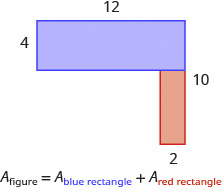
The blue rectangle has a width of [latex]12[/latex] and a length of [latex]4[/latex] The red rectangle has a width of [latex]2[/latex], but its length is not labelled. The right side of the figure is the length of the red rectangle plus the length of the blue rectangle. Since the right side of the blue rectangle is [latex]4[/latex] units long, the length of the red rectangle must be [latex]6[/latex] units.
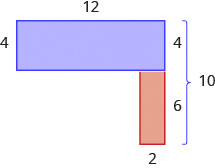
[latex]\begin{eqnarray*}A_{figure}&=&A_{blue\;rectangle}\;+\;A_{red\;rectangle}\\A_{figure\;}&=&bh\;+\;bh\\A_{figure}&=&12\;\times\;4\;+\;2\;\times\;6\;\\A_{figure}&=&48\;+12\\A_{figure}&=&60\\\end{eqnarray*}[/latex]
The area of the figure is [latex]60[/latex] square units.
Is there another way to split this figure into two rectangles? Try it, and make sure you get the same area.
Example 6.3.5
Find the area of the shaded region.
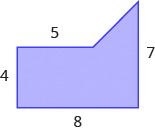
Solution
We can break this irregular figure into a triangle and rectangle. The area of the figure will be the sum of the areas of triangle and rectangle.
The rectangle has a length of [latex]8[/latex] units and a width of [latex]4[/latex] units.
We need to find the base and height of the triangle.
Since both sides of the rectangle are [latex]4[/latex], the vertical side of the triangle is [latex]3[/latex], which is [latex]7-4[/latex].
The length of the rectangle is [latex]8[/latex], so the base of the triangle will be [latex]3[/latex], which is [latex]8-4[/latex].
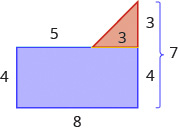
Now we can add the areas to find the area of the irregular figure.
[latex]\begin{eqnarray*}A_{Figure}\;&=&A_{rectangle}\;+\;A_{triangle}\\A_{Figure}\;&=&\;lw\;+\;\frac12bh\\A_{Figure}\;&=&\;8\;\times\;4\;+\frac12\;\times\;3\;\times\;3\\A_{Figure}\;&=&\;32\;+\;4.5\\A_{Figure}\;&=&\;36.4\;sq.\;units\end{eqnarray*}[/latex]
The area of the figure is [latex]36.5[/latex] square units.
Example 6.3.6
A high school track is shaped like a rectangle with a semi-circle (half a circle) on each end. The rectangle has length [latex]105[/latex] meters and width [latex]68[/latex] meters. Find the area enclosed by the track. Round your answer to the nearest hundredth.
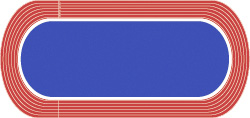
Solution
We will break the figure into a rectangle and two semi-circles. The area of the figure will be the sum of the areas of the rectangle and the semicircles.
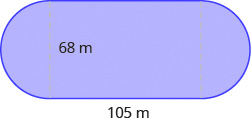
The rectangle has a length of [latex]105[/latex]m and a width of [latex]68[/latex]m. The semi-circles have a diameter of [latex]68[/latex]m, so each has a radius of [latex]34[/latex]m.
[latex]\begin{eqnarray*}A_{Figure}\;&=&A_{rectangle}\;+\;A_{semicircles}\\A_{Figure}\;&=&\;bh\;+\;2(\frac12\mathrm\pi\times\mathrm r^2)\\A_{Figure}\;&\approx&\;105\;\times\;68\;+\left(\frac12\times3.14\times34^2\right)\\A_{Figure}\;&\approx&\;7140\;+3629.84\\A_{Figure}\;&\approx&\;10,769.84\end{eqnarray*}[/latex]
The area enclosed is [latex]10,769.84[/latex] square meters.
Try It
14) Find the area:

Solution
[latex]103.2[/latex] sq. units
Try It
15) Find the area:
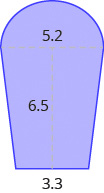
Solution
[latex]38.24[/latex] sq. units
Key Concepts
-
- Problem Solving Strategy for Geometry Applications
- Read the problem and make sure you understand all the words and ideas. Draw the figure and label it with the given information.
- Identify what you are looking for.
- Name what you are looking for. Choose a variable to represent that quantity.
- Translate into an equation by writing the appropriate formula or model for the situation. Substitute in the given information.
- Solve the equation using good algebra techniques.
- Check the answer in the problem and make sure it makes sense.
- Answer the question with a complete sentence.
- Problem Solving Strategy for Geometry Applications
-
- Properties of Circles
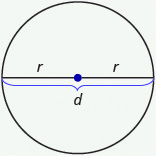
-
- [latex]d\;=\;2r[/latex]
- Circumference: [latex]C\;=\;2\mathrm{\pi r}[/latex] or [latex]C\;=\;\mathrm{\pi d}[/latex]
- Area: [latex]\mathrm A\;=\;\mathrm{\pi r}^2[/latex]
Self Check
After completing the exercises, use this checklist to evaluate your mastery of the objectives of this section.
After looking at the checklist, do you think you are well prepared for the next section? Why or why not?
Glossary
- irregular figure
- An irregular figure is a figure that is not a standard geometric shape. Its area cannot be calculated using any of the standard area formulas.
An irregular figure is a figure that is not a standard geometric shape. Its area cannot be calculated using any of the standard area formulas.

